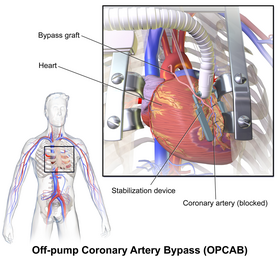| Off-pump coronary artery bypass (OPCAB) | |
|---|---|
 OPCAB OPCAB | |
| Specialty | Cardiothoracic surgery |
| MeSH | D047549 |
| [edit on Wikidata] | |
Off-pump coronary artery bypass (OPCAB), or beating-heart surgery, is a form of coronary artery bypass graft (CABG) surgery performed without cardiopulmonary bypass (heart-lung machine) as a treatment for coronary heart disease. It was primarily developed in the early 1990s by Dr. Amano Atsushi. Historically, during bypass surgeries, the heart is stopped and a heart-lung machine takes over the work of the heart and lungs. When a cardiac surgeon chooses to perform the CABG procedure off-pump (OPCAB) the heart is still beating while the graft attachments are made to bypass a blockage.
Off-pump coronary artery bypass was developed partly to avoid the complications of cardiopulmonary bypass during cardiac surgery. It had been believed that cardiopulmonary bypass causes a post-operative cognitive decline known as a postperfusion syndrome (informally called "pumphead"), but research has shown no long-term difference between on and off pump coronary artery bypass in patients of lower risk. This is probably because the pump is not the main cause of brain damage but is due to the formation of a clot or embolus.
Sometimes, the fatty type materials that collects to form a blockage or line on the walls of an artery may break loose during CABG procedure manipulation. This debris can result in clots, or emboli, that may interrupt the flow of blood to the brain, causing neurological damage or even stroke. Data analysis from beating-heart surgery patients shows a significant reduction in the release of this debris with correspondingly lower stroke rates.
The fatty emboli which cause brain damage are generated when the large artery from the heart (aorta) is manipulated and although these are reduced in most off-pump coronary bypass surgeries they are not eliminated because the aorta is still used as a site to attach some of the grafts. A growing number of OPCAB surgeons, however, are avoiding the aorta completely, known as "anaortic" or no-touch coronary bypass surgery, by taking all their grafts from sites other than the aorta (e.g. the internal mammary arteries.). This results in a very low risk of stroke, actually less than occurs during percutaneous coronary intervention.
In addition to off-pump surgery being associated with the clinical benefits of a reduced risk of stroke or memory problems, patients also typically have a faster recovery and shorter hospital stay, fewer blood transfusions, and fewer unwanted inflammatory/immune response issues.
Minimally invasive direct coronary artery bypass surgery (MIDCAB) is a form of OPCAB that involves an incision rather than cutting into the sternum. An advanced form of this is totally endoscopic coronary artery bypass surgery (TECAB) that uses robotic surgery.
Off-pump surgery can be more technically challenging. The technique has a steep learning curve, but with adequate training and experience, the quality of the anastomoses has been shown to be similar to on-pump results in surgeons with comparable experience
On February 18, 2012, Amano Atsushi performed a successful off-pump coronary artery bypass operation on Emperor Akihito.
References
- Postperfusion syndrome
- Zhao, Dong Fang (February 28, 2017). "Coronary Artery Bypass Grafting With and Without Manipulation of the Ascending Aorta: A Network Meta-Analysis". Journal of the American College of Cardiology. 69 (8): 924–936. doi:10.1016/j.jacc.2016.11.071. PMID 28231944.
- Ross, Donald (Summer 2012). "Anaortic Coronary Bypass Surgery". Seminars in Thoracic and Cardiovascular Surgery. 24 (2): 90–92. doi:10.1053/j.semtcvs.2012.04.005. PMID 22920523.
- Misfeld, Martin; Brereton JL; et al. (August 2011). "Neurological complications after off-pump coronary artery grafting with and without aortic manipulation". J. Thorac. Cardiovasc. Surg. 142 (2): e11 – e17. doi:10.1016/j.jtcvs.2010.11.034. PMID 21281950.
- Cremer, J; Schoettler, J; Thiem, A; Grothusen, C; Hoffmann, G (2011). "The MIDCAB approach in its various dimensions". HSR Proceedings in Intensive Care & Cardiovascular Anesthesia. 3 (4): 249–53. PMC 3563440. PMID 23440055.
- Purmessur, R; Wijesena, T; Ali, J (31 July 2023). "Minimal-Access Coronary Revascularization: Past, Present, and Future". Journal of Cardiovascular Development and Disease. 10 (8): 326. doi:10.3390/jcdd10080326. PMC 10455416. PMID 37623339.
- http://ajw.asahi.com/article/behind_news/social_affairs/AJ201205230073
External links
- Myocardial Revascularization without Cardiopulmonary Bypass chapter by Todd M. Dewey and Michael J. Mack in Cardiac Surgery in the Adult
- Canadian study to test value of heart-lung machine during cardiac surgery
- Coronary Artery Bypass Grafting With and Without Manipulation of the Ascending Aorta: A Network Meta-Analysis